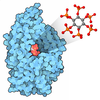+ Open data
Open data
- Basic information
Basic information
| Entry | Database: PDB / ID: 8u89 | ||||||
|---|---|---|---|---|---|---|---|
| Title | The structure of the PP2A-B56Delta holoenzyme mutant - E197K | ||||||
 Components Components |
| ||||||
 Keywords Keywords | CELL CYCLE / complex / phosphatase | ||||||
| Function / homology |  Function and homology information Function and homology informationmeiotic spindle elongation / Integration of energy metabolism / PP2A-mediated dephosphorylation of key metabolic factors / regulation of microtubule binding / MASTL Facilitates Mitotic Progression / regulation of meiotic cell cycle process involved in oocyte maturation / mitotic sister chromatid separation / protein serine/threonine phosphatase complex / protein phosphatase type 2A complex / meiotic sister chromatid cohesion, centromeric ...meiotic spindle elongation / Integration of energy metabolism / PP2A-mediated dephosphorylation of key metabolic factors / regulation of microtubule binding / MASTL Facilitates Mitotic Progression / regulation of meiotic cell cycle process involved in oocyte maturation / mitotic sister chromatid separation / protein serine/threonine phosphatase complex / protein phosphatase type 2A complex / meiotic sister chromatid cohesion, centromeric / peptidyl-serine dephosphorylation / peptidyl-threonine dephosphorylation / FAR/SIN/STRIPAK complex / Regulation of glycolysis by fructose 2,6-bisphosphate metabolism / positive regulation of microtubule binding / Inhibition of replication initiation of damaged DNA by RB1/E2F1 / female meiotic nuclear division / protein phosphatase regulator activity / protein antigen binding / GABA receptor binding / APC truncation mutants have impaired AXIN binding / AXIN missense mutants destabilize the destruction complex / Truncations of AMER1 destabilize the destruction complex / Initiation of Nuclear Envelope (NE) Reformation / positive regulation of extrinsic apoptotic signaling pathway in absence of ligand / ERKs are inactivated / Beta-catenin phosphorylation cascade / Signaling by GSK3beta mutants / CTNNB1 S33 mutants aren't phosphorylated / CTNNB1 S37 mutants aren't phosphorylated / CTNNB1 S45 mutants aren't phosphorylated / CTNNB1 T41 mutants aren't phosphorylated / regulation of growth / Disassembly of the destruction complex and recruitment of AXIN to the membrane / negative regulation of epithelial to mesenchymal transition / negative regulation of glycolytic process through fructose-6-phosphate / positive regulation of NLRP3 inflammasome complex assembly / Platelet sensitization by LDL / CTLA4 inhibitory signaling / protein serine/threonine phosphatase activity / myosin phosphatase activity / protein-serine/threonine phosphatase / regulation of cell differentiation / T cell homeostasis / negative regulation of peptidyl-threonine phosphorylation / ERK/MAPK targets / mesoderm development / protein phosphatase activator activity / regulation of G1/S transition of mitotic cell cycle / phosphoprotein phosphatase activity / DARPP-32 events / chromosome, centromeric region / negative regulation of phosphatidylinositol 3-kinase/protein kinase B signal transduction / lateral plasma membrane / negative regulation of hippo signaling / Nonsense Mediated Decay (NMD) enhanced by the Exon Junction Complex (EJC) / Amplification of signal from unattached kinetochores via a MAD2 inhibitory signal / Cyclin A/B1/B2 associated events during G2/M transition / Mitotic Prometaphase / : / EML4 and NUDC in mitotic spindle formation / Loss of Nlp from mitotic centrosomes / Loss of proteins required for interphase microtubule organization from the centrosome / Recruitment of mitotic centrosome proteins and complexes / Recruitment of NuMA to mitotic centrosomes / Anchoring of the basal body to the plasma membrane / Resolution of Sister Chromatid Cohesion / protein dephosphorylation / AURKA Activation by TPX2 / protein tyrosine phosphatase activity / meiotic cell cycle / chromosome segregation / RHO GTPases Activate Formins / response to lead ion / RAF activation / Spry regulation of FGF signaling / regulation of protein phosphorylation / positive regulation of protein serine/threonine kinase activity / tau protein binding / Degradation of beta-catenin by the destruction complex / PKR-mediated signaling / spindle pole / Negative regulation of MAPK pathway / Separation of Sister Chromatids / Cyclin D associated events in G1 / microtubule cytoskeleton / Regulation of PLK1 Activity at G2/M Transition / Regulation of TP53 Degradation / mitotic cell cycle / nervous system development / PI5P, PP2A and IER3 Regulate PI3K/AKT Signaling / protein-containing complex assembly / intracellular signal transduction / neuron projection / protein heterodimerization activity / membrane raft / neuronal cell body / glutamatergic synapse / dendrite / synapse Similarity search - Function | ||||||
| Biological species |  Homo sapiens (human) Homo sapiens (human) | ||||||
| Method | ELECTRON MICROSCOPY / single particle reconstruction / cryo EM / Resolution: 3.3 Å | ||||||
 Authors Authors | Wu, C.G. / Xing, Y. | ||||||
| Funding support |  United States, 1items United States, 1items
| ||||||
 Citation Citation |  Journal: Proc Natl Acad Sci U S A / Year: 2024 Journal: Proc Natl Acad Sci U S A / Year: 2024Title: B56δ long-disordered arms form a dynamic PP2A regulation interface coupled with global allostery and Jordan's syndrome mutations. Authors: Cheng-Guo Wu / Vijaya K Balakrishnan / Ronald A Merrill / Pankaj S Parihar / Kirill Konovolov / Yu-Chia Chen / Zhen Xu / Hui Wei / Ramya Sundaresan / Qiang Cui / Brian E Wadzinski / Mark R ...Authors: Cheng-Guo Wu / Vijaya K Balakrishnan / Ronald A Merrill / Pankaj S Parihar / Kirill Konovolov / Yu-Chia Chen / Zhen Xu / Hui Wei / Ramya Sundaresan / Qiang Cui / Brian E Wadzinski / Mark R Swingle / Alla Musiyenko / Wendy K Chung / Richard E Honkanen / Aussie Suzuki / Xuhui Huang / Stefan Strack / Yongna Xing /  Abstract: Intrinsically disordered regions (IDR) and short linear motifs (SLiMs) play pivotal roles in the intricate signaling networks governed by phosphatases and kinases. B56δ (encoded by ) is a regulatory ...Intrinsically disordered regions (IDR) and short linear motifs (SLiMs) play pivotal roles in the intricate signaling networks governed by phosphatases and kinases. B56δ (encoded by ) is a regulatory subunit of protein phosphatase 2A (PP2A) with long IDRs that harbor a substrate-mimicking SLiM and multiple phosphorylation sites. De novo missense mutations in cause intellectual disabilities (ID), macrocephaly, Parkinsonism, and a broad range of neurological symptoms. Our single-particle cryo-EM structures of the PP2A-B56δ holoenzyme reveal that the long, disordered arms at the B56δ termini fold against each other and the holoenzyme core. This architecture suppresses both the phosphatase active site and the substrate-binding protein groove, thereby stabilizing the enzyme in a closed latent form with dual autoinhibition. The resulting interface spans over 190 Å and harbors unfavorable contacts, activation phosphorylation sites, and nearly all residues with ID-associated mutations. Our studies suggest that this dynamic interface is coupled to an allosteric network responsive to phosphorylation and altered globally by mutations. Furthermore, we found that ID mutations increase the holoenzyme activity and perturb the phosphorylation rates, and the severe variants significantly increase the mitotic duration and error rates compared to the normal variant. | ||||||
| History |
|
- Structure visualization
Structure visualization
| Structure viewer | Molecule:  Molmil Molmil Jmol/JSmol Jmol/JSmol |
|---|
- Downloads & links
Downloads & links
- Download
Download
| PDBx/mmCIF format |  8u89.cif.gz 8u89.cif.gz | 259.1 KB | Display |  PDBx/mmCIF format PDBx/mmCIF format |
|---|---|---|---|---|
| PDB format |  pdb8u89.ent.gz pdb8u89.ent.gz | 202.8 KB | Display |  PDB format PDB format |
| PDBx/mmJSON format |  8u89.json.gz 8u89.json.gz | Tree view |  PDBx/mmJSON format PDBx/mmJSON format | |
| Others |  Other downloads Other downloads |
-Validation report
| Summary document |  8u89_validation.pdf.gz 8u89_validation.pdf.gz | 1.5 MB | Display |  wwPDB validaton report wwPDB validaton report |
|---|---|---|---|---|
| Full document |  8u89_full_validation.pdf.gz 8u89_full_validation.pdf.gz | 1.6 MB | Display | |
| Data in XML |  8u89_validation.xml.gz 8u89_validation.xml.gz | 43 KB | Display | |
| Data in CIF |  8u89_validation.cif.gz 8u89_validation.cif.gz | 63.9 KB | Display | |
| Arichive directory |  https://data.pdbj.org/pub/pdb/validation_reports/u8/8u89 https://data.pdbj.org/pub/pdb/validation_reports/u8/8u89 ftp://data.pdbj.org/pub/pdb/validation_reports/u8/8u89 ftp://data.pdbj.org/pub/pdb/validation_reports/u8/8u89 | HTTPS FTP |
-Related structure data
| Related structure data |  42018MC  8u1xC M: map data used to model this data C: citing same article ( |
|---|---|
| Similar structure data | Similarity search - Function & homology  F&H Search F&H Search |
- Links
Links
- Assembly
Assembly
| Deposited unit | 
|
|---|---|
| 1 |
|
- Components
Components
| #1: Protein | Mass: 65378.344 Da / Num. of mol.: 1 Source method: isolated from a genetically manipulated source Source: (gene. exp.)  Homo sapiens (human) / Gene: PPP2R1A / Production host: Homo sapiens (human) / Gene: PPP2R1A / Production host:  Trichoplusia ni (cabbage looper) / References: UniProt: P30153 Trichoplusia ni (cabbage looper) / References: UniProt: P30153 | ||
|---|---|---|---|
| #2: Protein | Mass: 70089.742 Da / Num. of mol.: 1 / Mutation: E197K Source method: isolated from a genetically manipulated source Source: (gene. exp.)  Homo sapiens (human) / Gene: PPP2R5D / Production host: Homo sapiens (human) / Gene: PPP2R5D / Production host:  Trichoplusia ni (cabbage looper) / References: UniProt: Q14738 Trichoplusia ni (cabbage looper) / References: UniProt: Q14738 | ||
| #3: Protein | Mass: 35636.152 Da / Num. of mol.: 1 Source method: isolated from a genetically manipulated source Source: (gene. exp.)  Homo sapiens (human) / Gene: PPP2CA / Production host: Homo sapiens (human) / Gene: PPP2CA / Production host:  Trichoplusia ni (cabbage looper) Trichoplusia ni (cabbage looper)References: UniProt: P67775, protein-serine/threonine phosphatase | ||
| #4: Chemical | | Has ligand of interest | Y | |
-Experimental details
-Experiment
| Experiment | Method: ELECTRON MICROSCOPY |
|---|---|
| EM experiment | Aggregation state: PARTICLE / 3D reconstruction method: single particle reconstruction |
- Sample preparation
Sample preparation
| Component | Name: Protein Phosphatase 2A B56 Delta holoenzyme mutant - E197K Type: COMPLEX / Entity ID: #1-#3 / Source: RECOMBINANT |
|---|---|
| Molecular weight | Experimental value: NO |
| Source (natural) | Organism:  Homo sapiens (human) Homo sapiens (human) |
| Source (recombinant) | Organism:  Trichoplusia ni (cabbage looper) Trichoplusia ni (cabbage looper) |
| Buffer solution | pH: 8 |
| Specimen | Conc.: 0.4 mg/ml / Embedding applied: NO / Shadowing applied: NO / Staining applied: NO / Vitrification applied: YES |
| Specimen support | Grid material: GOLD / Grid type: UltrAuFoil R1.2/1.3 |
| Vitrification | Cryogen name: ETHANE / Humidity: 100 % / Chamber temperature: 277 K |
- Electron microscopy imaging
Electron microscopy imaging
| Experimental equipment |  Model: Titan Krios / Image courtesy: FEI Company |
|---|---|
| Microscopy | Model: FEI TITAN KRIOS |
| Electron gun | Electron source:  FIELD EMISSION GUN / Accelerating voltage: 300 kV / Illumination mode: FLOOD BEAM FIELD EMISSION GUN / Accelerating voltage: 300 kV / Illumination mode: FLOOD BEAM |
| Electron lens | Mode: BRIGHT FIELD / Nominal defocus max: 2200 nm / Nominal defocus min: 700 nm |
| Image recording | Electron dose: 49 e/Å2 / Film or detector model: GATAN K3 (6k x 4k) |
- Processing
Processing
| EM software |
| ||||||||||||||||||||||||
|---|---|---|---|---|---|---|---|---|---|---|---|---|---|---|---|---|---|---|---|---|---|---|---|---|---|
| CTF correction | Type: PHASE FLIPPING AND AMPLITUDE CORRECTION | ||||||||||||||||||||||||
| 3D reconstruction | Resolution: 3.3 Å / Resolution method: FSC 0.143 CUT-OFF / Num. of particles: 276448 / Symmetry type: POINT | ||||||||||||||||||||||||
| Refine LS restraints |
|
 Movie
Movie Controller
Controller




 PDBj
PDBj



















